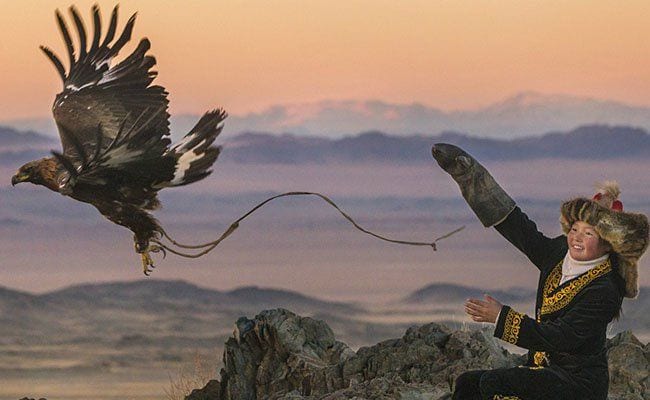
Aisholpan Nurgaiv, the proud hero at the center of Otto Bell’s documentary The Eagle Huntress, is a role model for a new generation. The 13-year-old shattered centuries-old traditions of gender inequity by simply being herself and chasing her dream of becoming the first-ever female eagle hunter in her native Mongolia, and from this soaring, visually striking document of her unlikely journey, she emerges as one of the most inspirational real-life figures to grace a big screen in recent memory.
Kazakh eagle hunters raise their majestic birds from chicks into obedient predators, soaring through the air and snatching up small animals in a matter of seconds, all at their master’s command. The bond between hunter and feathered friend must be an extraordinarily tight one to become champion at the annual Golden Eagle Festival, and even tighter to survive long traversals across icy, mountainous terrain. It’s a tall order for anyone, but Aisholpan, our rosy-cheeked heroine, is all smiles as she trains toward her dream, guided by her devoted father, a former champion himself.
Aisholpan’s quest feels plucked straight from the pages of a children’s book, and Bell knows it, accentuating the stranger-than-fiction aspects of the story with the film’s striking presentation. Fittingly cast Star Wars phenomenon Daisy Ridley narrates the tale, and cinematographer Simon Niblett captures the spectacularly cinematic art of eagle hunting in astonishing detail. From catching seemingly impossible, sweeping shots of Aisholpan repelling down a craggy cliff to catch her eaglet, to later following the bird in slow motion as it soars toward its target across the snow-blanketed landscape, the imagery is almost too good to be true.
In fact, if there’s a criticism to be levied against the movie, it’s that it at times feels almost scripted. It’s hard to believe some of the breathtaking scenes were shot on the fly, and some of them are shot from so many angles that one wonders how what we’re seeing couldn’t have been choreographed. Bell’s made an incredibly pretty film that’s at times so ravishing it soars a little too high, so transportive that it makes you forget it takes place in the very world we live in.
What remedies this minor issue is Aisholpan’s warm, devoted father. While his daughter grins and plays and seems all but indestructible in the face of adversity, the veteran eagle hunter’s fatherly love and pride is absolutely overflowing, despite his reserved exterior. He grounds the picture in an interesting way, because he’s more keenly aware of the controversy surrounding Aisholpan’s enthusiasm for eagle hunting, and after an infuriating series of talking-head male elders making sexist comments about her unprecedented entry into the hunting competition, her father’s unwavering faith in her talents feels like a warm blanket in a snowstorm of antiquated gender bias.
At times, Bell follows Aisholpan as she goes about her normal daily activities, painting her nails, huddling with her classmates as they gossip and giggle. She’s nothing but sweet and humble, and it’s astonishing how these small moments at once humanize her and add to her mystique. If her accomplishments don’t impress you for some reason, the sheer cuteness of her relationship with her trusty eagle will no doubt win you over.
There’s no doubt that Aisholpan will be a point of inspiration and motivation for any young girl who sees The Eagle Huntress, but she’s more than a role model for the demographic to which she belongs. It’s not hard to imagine young boys looking up to her and dreaming of being eagle hunters themselves. She’s fought back gender oppression (with help from her father) by simply being happy, being herself and being excellent at what she does, and that’s a shining example to follow for anyone, of any age, who’s been discouraged, disenfranchised, and marginalized.


![Call for Papers: All Things Reconsidered [MUSIC] May-August 2024](https://www.popmatters.com/wp-content/uploads/2024/04/all-things-reconsidered-call-music-may-2024-720x380.jpg)



